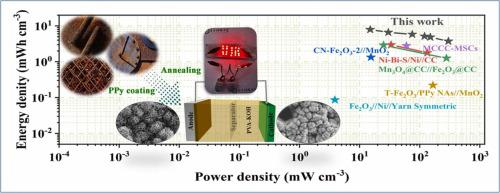Journal of Alloys and Compounds ( IF 5.8 ) Pub Date : 2022-07-08 , DOI: 10.1016/j.jallcom.2022.166055
Baolong Sun , Mengqi Yao , Yunjian Chen , Xianzhong Tang , Wencheng Hu , Suresh C. Pillai

|
Flower-like rust with porous structure can be obtained on the Fe plate by accelerated corrosion in the marine atmosphere. A core-shell structure of γ-Fe2O3 @PPy was developed through annealing and in situ chemical polymerization of pyrrole. The dehydroxylation after annealing enriches the inherent pore structure of rust. The conductive PPy layer with the capacitive properties were found to improve the stability of iron-based anodes while enhancing the charge storage performance. The rust-based composite exhibited superior capacitance performance over the original rust. By matching with a cathode from nickel-cobalt layered double hydroxide (NiCoLDH) based porous Ni network, the asymmetric device delivered a high volumetric energy density of 7.9 mWh cm–3 at a power density of 14.99 mW cm–3, and favorable cycle stability (capacitance retention of 90.1% after 8000 cycles). Most importantly, the energy storage mechanism of rust-based electrodes with flower-like structures was discussed in detail. The recycling and reuse of rust resources were successfully realized by the direct utilization of rusted steel as anode materials for supercapacitor applications.
中文翻译:

从铁锈中轻松制造花状 γ-Fe2O3 @PPy,用于高性能非对称超级电容器
在海洋大气中加速腐蚀,可在铁板上获得具有多孔结构的花状锈。γ-Fe 2 O 3 @PPy的核壳结构是通过吡咯的退火和原位化学聚合形成的。退火后的脱羟基丰富了铁锈固有的孔结构。发现具有电容特性的导电PPy层可以提高铁基阳极的稳定性,同时提高电荷存储性能。基于锈的复合材料表现出优于原始锈的电容性能。通过与基于镍钴层状双氢氧化物 (NiCoLDH) 的多孔 Ni 网络的阴极相匹配,该不对称器件提供了 7.9 mWh cm –3的高体积能量密度功率密度为 14.99 mW cm -3,循环稳定性良好(8000 次循环后电容保持率为 90.1%)。最重要的是,详细讨论了具有花状结构的锈基电极的储能机制。生锈钢直接用作超级电容器负极材料,成功实现了生锈资源的回收再利用。































 京公网安备 11010802027423号
京公网安备 11010802027423号